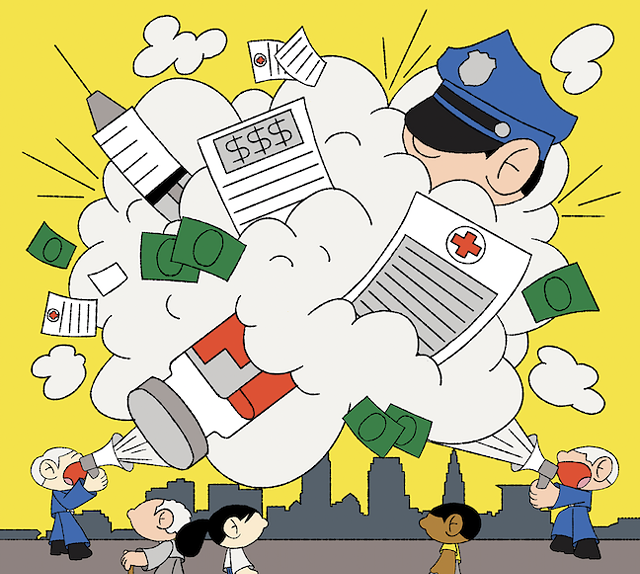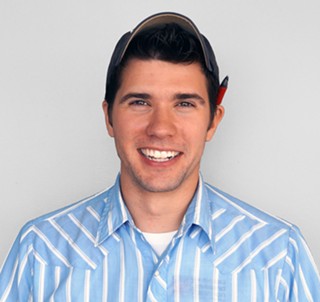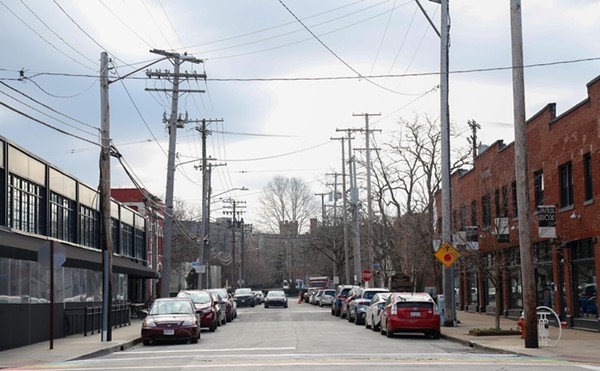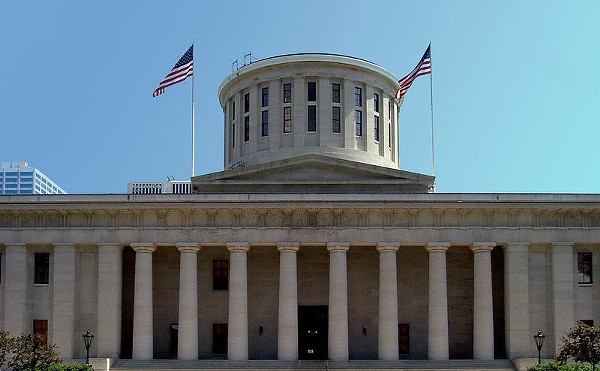Cuyahoga County voters will decide between Democrat Chris Ronayne and Republican Lee Weingart in the race to succeed Armond Budish as county executive this November. Scene sat down with both candidates in recent weeks, giving them space to clarify their platforms, respond to criticisms and make their pitches to voters as the summer campaign season heats up.
(The conversations below have been lightly edited for length and clarity.)
We met Weingart at the 27 Club in the Flats, owned by Weingart’s favorite musical artist, Machine Gun Kelly. Over coffee, the Republican in the race began talking about his work with Black small business owners during the pandemic. Quickly, our conversation veered to the woeful voter turnout in Cuyahoga County. We suggested that there was a straightforward relationship between residents’ material conditions and their engagement in the democratic process…
Sam Allard: ...It doesn’t matter if you’re a Democrat or a Republican. I’m still poor. No one gives a shit about me. Why bother?
Lee Weingart: Right. Think about the Cleveland mayor’s race last year. It was the first open race in 15 years, and yet there was a smaller turnout than in 2017, when Frank Jackson coasted to his third re-election. I’ve talked to people on the East Side. There’s a sense of dejection about the system. But when I talk about what I want to do, they tell me: If you really do that, I’ll vote for you.
On the East Side? Are you targeting Tariq Shabazz voters, given his performance in the primary against Ronayne?
I will say this: I was shocked at how well Tariq did and how poorly Chris did, especially when you think that Chris spent $300,000 and Tariq spent $700 and that Chris had the endorsement of the Democratic Party and Justin Bibb. The fact that he lost just about every East Side ward, including the three that comprise University Circle [6, 7 and 9], and East Cleveland, which abuts University Circle, tells me that those who knew him best supported him least. I got to know Tariq really well on the trail, and I think my ideas and his ideas are much more similar than his and Chris’s.
Which ones specifically?
Take a look at the jail. Chris has been mum on the size of the jail, the cost of the jail and the location of the jail. He appears to be fine with a $600 million jail with more than 1,200 inmates on a contaminated site. Tariq and I are very clear. I say no more than 1,200 capacity, certainly not on a contaminated site, and no more than $300 million. On the Global Center, we both agree that spending $46 million on that facility is ridiculous.
You’d like to sell the Global Center, correct?
I would sell the Medical Mart and the Hilton Hotel.
Even if you couldn’t fetch anywhere near what the public paid for them?
According to who, Jeff Applebaum? He’s the only one who’s ever quoted! I say let’s bring in an outside party to determine how best to sell it. Look at Calfee Halter – that’s the old post office downtown that they turned into their law firm. If you can reconfigure that into a law firm, why can’t you reconfigure the Global Center into something else? Someone smarter than the local consultants can figure this out and get it off our books. We pay $50 million per year on debt service for the Global Center and Hilton Hotel. Meanwhile, we don’t have resources for children at risk, seniors in crisis, families who need counseling, people who are addicted.
I presume that $50 million doesn’t include the additional Hilton bailout during the pandemic.
It does not. That hotel has never made money. Never. And the notion that the Medical Mart breaks even is ridiculous. But they get away with it. There’s nobody to call the bluff. There is a conspiracy of nonprofits downtown and nobody ever calls their bluffs. When I’m county executive, I’m not going to let these guys pull the wool over my eyes.
Who do you mean here? Which nonprofits?
What I mean is, there are no checks and balances in the system right now. Whenever someone has an idea, they all get together and say, “This is a great idea,” and no one ever challenges it.
I agree! But who are you talking about?
Well, like, for example, JumpStart gets a ton of money. I was on a phone call recently, and [CEO] Ray Leach said they’d invested $71 million since they started JumpStart. Well, I know for a fact they’ve gotten at least $200 million in public funding. So where’s the other $130 million? The Hilton is another one. When they said, let’s build it, there was no one to say, this is a bad idea, it’s too expensive, it’ll never make the money back. Same with the Medical Mart. The city and county were hand in hand, convinced that this would be some economic catalyst for downtown.
Ronayne agrees with organizations like Destination Cleveland that the convention business is good for Cleveland, and he has no interest in selling the facility. You’ve really amplified this distinction between you. Why?
Because of why he feels that way. He agrees with Destination Cleveland because he is an insider. The people on these boards are his friends. If there’s an idea that he’s got, they’re going to support it, and he’s going to support their ideas. This is what I’m saying. There’s no control on these out-of-control ideas. Somebody somewhere needs to say, hold on a second, let’s take a sanity check. The purpose of government is not to be the developer of last resort, which is what we’ve become. When I was commissioner, on my way out in 1997, the county’s total debt was $100 million. Today it’s $1.2 billion, largely because of the Convention Center, the Global Center and the Hilton Hotel.
The choice for County Executive is between two older white guys, so why on earth should Black voters pick the Republican? Your party has shown these voters nothing but contempt and is increasingly full of Looney Tunes on the fringe. What do you say to that?
What I say, first of all, is that this is a local race, and we don’t deal with the national issues that have separated this country so much, particularly on social issues. And then, to voters, I just outline my vision for county government, which is getting back to the basic nuts and bolts. Smaller government that’s less expensive but is more active in the urban core.
I hear you, but–
Look, when I talk about that message to Black voters, they tell me, if you do that, I would vote for you. I say, I’m gonna do it! The outer suburbs in the county are in pretty good shape. The challenges we have are in the urban core. And local government’s function should be to help those who have not, not those who have. If we do that, we can ultimately shrink the social services budget of Cuyahoga County and lower taxes for everybody. We should all be invested in this.
What’s your position on January 6? Do you believe the 2020 election was stolen from Donald Trump?
I believe that Joe Biden won the race, that January 6 was an insurrection, and that those who participated should be punished. I am against insurrections of any kind, and it doesn’t matter which party is leading them. I abhor violence, and that includes violent protest.
How would you define your personal Conservative values?
I was raised in a Republican family. My parents are Republicans. And this was in Cleveland Heights. Go figure that one out. I’ve always been a believer in the Republican Party, the older Republican Party. I’m a student of history. The party was formed in 1854 with a single purpose in mind, which was to end slavery. And for the next 100 years, it was the party of Civil Rights. Then in the 1980s, the party made the decision to pursue white votes to the exclusion of Black votes everywhere. I’d like to see the party get back to its historic roots, getting back to supporting civil rights for all people. Teddy Roosevelt. Dwight Eisenhower. Bob Taft. George Voinovich. Those are Republicans that I admire.
You realize that the party’s historic roots bear like zero resemblance to the GOP today, especially the wing I mentioned, the MAGA branch or whatever. Doesn’t that bother you?
I’m not connected to that wing at all, first of all, but I see both parties as extreme these days. You have the Squad on the Left and then Super MAGA on the Right, and I think that most people are somewhere in the middle. I think they’d like to have a little more moderation in trying to solve problems. Right now, we’re so partisan as a country that we can’t even talk about solving problems.
Maybe, but at the Ohio Statehouse the issue is not Leftwing Democrats. It’s Republicans, who have shown a total disregard for Ohio voters and who are passing increasingly unhinged legislation on wedge issues like guns and abortion. Doesn’t Cuyahoga County, the state’s so-called Democratic stronghold, have a responsibility to be a countervailing force in this climate?
I think if you look at polling on the issues you mentioned – guns and abortion specifically – you’ll find that most Americans, again, are somehwere in the middle. The legislature is clearly much further to the Right than the average Ohioan. I don’t think you’d see popular support for unlicensed concealed carry, for example. And as Republicans, we’re supposed to be sympathetic to the plight of the police, and very few police are in support of unlicensed concealed carry.
Since we’re on the subject, you’d identify as “pro-police”?
I am pro-police and pro-police reform. I think we need to have a strong police force that respects and treats people with dignity, which is why I go back to the [University Circle] policing issues.
I know you’ve hammered Ronayne on that, but it’s not like he sat on his hands after those stats on traffic stops came out, right? He formed a civilian review board, mandated bias training, and ordered body cameras.
You can tell me how effective that was, since the [percentage of black motorists stopped by UCI police] went up from 88% to 94% after the reporting came out. Bias training? I’ve seen the certificates. It’s like a kindergarten graduation. Congrats, you’ve graduated from a two-day seminar. I would’ve been sitting down with the police chief every month and demanding to see the numbers on the tickets they were issuing. And if every month, it was 90% Black drivers, I’d say, ‘What is going on here?” Chris should have known before the reporting came out, but the fact that 11 months later, the numbers went up? That leads me to believe he was sitting on his hands. Leadership is about leaning in, not making statements about how horrified you are.
Walk me through what you would have done in 2018, as deaths were piling up at the county jail.
I never would have got there in the first place. I never would have used the jail as a profit center. I never would have overcrowded it, never would have encouraged the suburbs to ship their defendants downtown, never would have understaffed it, never would have under-resourced it. It just never would have happened with me.
Okay, but for the purposes of this thought experiment.
It should have been a five-alarm fire. When I was county commissioner, we had one child die in the foster care system, and it was all hands on deck. The fact that eight people died before Budish even set foot in the jail is unthinkable, and then he goes to Akram Boutros to fire the whistleblower.
You want to go back to an elected sheriff. Why?
When I was county commissioner, we had an elected Sheriff, Gerald McFaul, who, as we all know near the end of his career, had some issues. But Gerry had to run every four years. And if somebody died while he was sheriff, he had to explain that to voters. So he hired the best people he could, and as a result, people didn’t die very often in the county jail. The current sheriff reports to the county executive or the county council, depending on the day of the week. It’s a reporting structure that creates confusion and leads to chaos.
You’ve also proposed expanding the sheriff’s deputies. What’s your rationale?
I want to add 100 deputies, yes. The primary role of the sheriff is to investigate major crimes: child trafficking, human trafficking, murder. If we could have more deputies helping the City of Cleveland and other suburban departments solve those crimes – literally putting the deputies in those departments – that puts more of their officers in the streets. That’s a way to stop crime at the source, and have more officers getting to know residents better.
You’ve called for 12 debates across the county with Chris Ronayne. What do you expect that level of engagement would show voters? What are the key distinctions you’re trying to make?
They’re going to show that I have a real vision for Cuyahoga County. And Ronayne, as the Plain Dealer has said, is a mush mouth. Just like at his City Club speech, he doesn’t say anything. I want to showcase my vision against whatever Ronayne’s is. Maybe he can explain what Healthy Cuyahoga means.
So you think he’s all talk?
From what I’ve seen, yes. I don’t see any numbers behind his proposals.
He strikes me as a relationship guy. People really like him. You don’t think there’s value in the sort of Justin Bibb leadership style, convening experts and all that?
Let me go back to where we started: That’s the last thing we need in a county executive.
What is?
A convener. An insider. We need somebody who calls it straight.
We met Ronayne at his campaign headquarters in Lakewood, in the repurposed Detroit Avenue frontage of an auto body shop. After chatting briefly with his campaign staff, we walked over to Propaganda Coffee – no pun intended – and began by discussing the personnel working for his campaign.
Sam Allard: I recognize a few faces from the Bibb team.
Chris Ronayne: Yeah, it’s frankly an honor to work with some of these younger campaign volunteers and paid staff. They see a better world than what they’ve experienced these past six years, and I’m channeling that. They’re a kinder generation that’s driving for real equity and real justice. The same issues are always going to be with us: jobs, safety, schools. But there’s a higher level of expectation now.
Talk to me about the primary. Were you surprised by how well Tariq Shabazz performed?
I felt good. To pick up 66% of the county was a significant achievement, particularly for an individual who’s never been on a countywide ballot – that being me. I think that we did well, and what our intel tells us is that we’ve got a ceiling to grow. With respect to the other third that voted for Tariq, I’m looking to gain those votes back. We want to make up ground in the eastern wards of the city of Cleveland and the near eastern suburbs. I think the turnout in those communities for Tariq Shabazz is not a surprise, given historical voting patterns.
These are predominantly Black areas, of course. The general election is now between two white guys. So what’s your pitch to Black voters?
My pitch is to remember our core values as Democrats. We are the party of justice, equity, women’s rights, the party of going against gun violence and unfettered gun possession. In Ohio, we are the party that believes in fair districting. My message is to remember our values, to remember that we are the party that unifies.
Were you discouraged by the outcome in the areas directly around University Circle? Should that be read as a referendum on your leadership at UCI?
No. Again, there are correlations between economics, race and voting patterns in those areas. And I see great opportunity to win those votes over to our side.
One of the policy fault lines between you and Lee right now is the Global Center. You’ve said you’d do anything but sell it in a fire sale. Can you clarify your position?
The building of the Global Center is, just matter-of-factly, connected to the rest of the Convention District. It’s the front door from St. Clair and it’s integrally connected to the whole. I think we would lose our shirts selling that building. This is a public asset, just like Public Auditorium is an asset. The future of the space I believe has value as a leasable asset. And I underline leasable. This could be private commercial space, nonprofit space. Some of the building should go toward what the overall district is about, which is destination management and development, i.e. travel and tourism. That’s a top-5 industry in Cleveland, and what I said at the City Club I stand by: The jobs in the hospitality industry depend on driving visitors to Cleveland. Many of these workers come from our most disadvantaged communities. If you start going down the road of selling it in a fire sale, you’re cutting off local jobs.
You realize, though, that voters overwhelmingly oppose spending any more public money on the facility?
Yes, and let me state this for the record. I do not think we need to spend $46 million on the Global Center. What we have to do is take a serious look at what we need. I was down there the other day at 8:30 in the morning. There were four elevators servicing four floors, and there wasn’t a big traffic jam. I’m not sure that godawful expensive escalators are the solution.
Yet Armond Budish and county council are charging full steam ahead with a plan that literally everyone hates. It’s outrageous.
What I keep coming back to is management. That’s what this county executive job is all about. My management instincts are: don’t sell the building, drive leasehold improvements, which is to say, drive tenants to make capital repairs on what they need. I don’t see that being popularly discussed at the county. We need to have conversations about what is the program, what are the repairs, rather than flood the building with $46 million to add different ways to access the same space. We’re putting the cart before the horse.
At the City Club, you said you needed more information on the new county jail before staking out a position. Where do you stand now?
For me, it’s a fix-it first mentality. Fix what we’ve got, because there are triaging needs that need to be addressed. I’ve talked with a broad coalition of workers and leaders who touch that jail, and none who actually work inside said the first priority should be to build a new one. They’ve said there are immediate issues: ranging from overcrowding to the basics of daily living –broken faucets, rotten food. These are immediate needs.
And it’s not like a new jail would open tomorrow. The current issues would persist for the duration of any construction process.
Correct. We’ve got to deal with that stuff right now. But on the new jail, once again, I believe the cart is before the horse. I’ve seen the consultants and I’ve participated in Zoom meetings, and we’re talking about the physical building before we’re talking about systems. Why are we talking about more beds instead of diversion and prevention? Everyone loves to talk about shiny objects in this town. But my M.O. on this is: slow down. This is a 50-100-year decision and we’ve got to get it right.
How would a Ronayne administration have responded to the jail deaths in 2018?
I would have appointed a crisis team. When you look at national averages across metros like ours, there are unfortunately some deaths that occur, maybe 2-4 deaths a year. But when you double that number, triple that number, you’ve got a problem. My instincts are: overcrowding is the problem. The common refrain here in Cuyahoga County is to spend big dollars on big new objects, when the crisis is management overload. I had a roundtable with corrections officers and expected hostility, but they were some of the strongest advocates for the prison population. They were telling me that overpopulation is critical, and we just don’t have enough manpower. Let’s work with them. I would have had a CO on that committee, I would have had a former incarcerated person on it, and other experts in the field.
At the beginning of the pandemic, judges came together and reduced the jail population by half. It was under 1,000 at one point. Why not force them to sustain those numbers?
In so many ways, we saw the best of humanity during the pandemic. Management of the jail population and diversion were at unparalleled levels. We probably handled emergency homelessness better than we ever had. And that was because people put their heads together. I’m seeing, unfortunately, judges are kept at arm’s length by the administration, and judges have a hell of a lot of stake in the outcomes here. My campaign right now is basically a preface to the job – meet with community partners about what’s possible.
What’s possible is reducing the jail population by half! That would certainly solve the overcrowding problem.
You’re hitting on the high notes of where I’m going with the campaign, and that is asking: When have we been best, and what are the best practices? And when have we failed and why? We should not be sheepish about asking why and how we’ve failed.
Are you in support of the city of Cleveland’s recent tax abatement policy?
I support the mayor. This is a home-rule state. The mayor went in the direction he went, taking a fairly measured approach. I think leadership needs to be about civic innovation, and if he finds that there’s a drop in income tax, he may have to pivot, but the mayor led this, the mayor is going to implement this, and I support him.
On the broader question of housing affordability, what are your policy plans for Cuyahoga County?
I would like to support CHN Partners’ idea for an affordable housing fund. I will initiate a housing department or division at the county. There’s enough need, from senior housing to affordable housing, to justify it. This is actually one of three major initiatives that I’d like to bring forth, in terms of departmental changes: Housing, Transportation and an Ombudsman’s Office. But you’ve got to walk the talk in terms of funding.
Where do you anticipate that funding coming from?
It could come from ARPA, to seed it. The operative for county government in the future needs to be about common sense. That’s why I’m trying to be deliberative about not throwing money at large-scale projects and focusing more on systems that lead to reform.
Beyond mandating an increase in minority contracting, which you’ve mentioned, what does equity look like in a Ronayne administration?
First of all, we need to target our investments. There is a diversity of communities in Cuyahoga County and there’s a range of needs and reasons why these communities draw upon the county’s resources. I think that in infrastructure and economic development, every community needs to be a part of that. We need to tackle our challenges by investing in places that have been disinvested in. More broadly, my lens is a Cuyahoga Works lens. When we look at how to help those who are work-eligible, where have the barriers been? How do we create communities that are vibrant and safe that get people ready to work? The issue isn’t the lack of jobs out there. The issue is the skills gap. Cuyahoga County needs to address everything that goes into that, from infant mortality to literacy.
How do you envision working with county council and repairing what has been a vindictive, fraught relationship with the executive in recent years?
Partnership is everything. My background as Chief of Staff, as Chief Development Director, as City Planning Director and then at University Circle, working with 40 institutions, is partnerships. Why are we making this so difficult? What I’ve seen too often is the element of surprise. I would never spring departmental cuts on directors at a budget hearing. Let’s talk about challenges in the budget, and if we have to make cuts, we wear that jacket together. This can’t be a jack-in-the-box administration.
How do you respond to charges that your extensive background with leaders in town make you too much of an insider?
I was looked at as the outsider in the race for county executive in the Democratic Party. I ran with that, and what we found were like-minded people who wanted to see change happen. In the community sense, I’m a church basements and a boardroom guy. I can be comfortable in both places, and I think that’s what you want in a leader. You want a person who’s going to be a partner with the corporate sector when it makes sense, but who isn’t going to be pushed around. That’ll equate to better deals for the public. Part of the problem with these deals is that we have inexperienced leaders crafting deals.
I’d actually argue that our leaders haven’t been crafting deals at all. They simply ratify the deals presented to them.
I couldn’t agree more. It’s been a one-way street. And it can’t be anymore. The art of the deal has been lost, and we need leaders who are crafting them on behalf of the public.
What do you see as the big distinctions between you and Lee?
On the trail, I have not paid much attention to Lee Weingart. He lost me at Hello. I tried to talk to him early last summer, just to get a baseline understanding, and he wouldn’t speak with me. Then he goes on the attack, and makes what I believe are false claims about his record. Saying he saved the Browns is an interesting claim. Saying he started the Land Bank is an interesting claim. Saying that the Medical Mart is folly while having lobbied for it is interesting. And when I say interesting, I mean I’m suspect. I think the tale of two candidates is: Who’s been about the work? Who has the experience? Who has engaged the public and been doing community development for 25 years? My question to Lee is, where have you been?
I mean, at his consulting firm?
Right, lobbying for fracking contracts and medical bill collectors.
You called him a “pretender” after Cleveland.com reported his Medical Mart lobbying.
I think he is! And I think he’s dividing this community. I think he’s race-baiting. I think when he says, “I need to get 22% of the Black vote,” that’s offensive. Isn’t that offensive? I want 100% of the Black vote, and I plan to work for it. The way he’s playing this campaign is pure gamesmanship, and it’s typical of the way we’ve seen his party operate. Divide the community. Distort the facts. Claim what you want.
Some of the policies he’s proposed I think are pretty good. In fact, even though he’s a Republican, he seems to be running politically to your left.
Look, I am a believer in building up, not tearing down. And I think some of Lee’s policies, and his leadership orientation, are about burning it down. My response is, if you burn it all down, what do you have left?
















